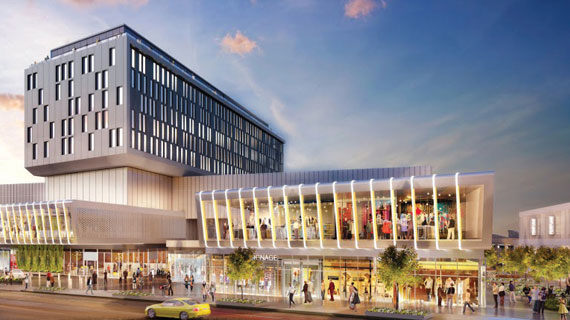Trending
Urban outletters
City gets a swath of off-price </br>stores seeking to draw </br>bargain-hungry shoppers

For years, the city’s department stores — not to mention their landlords — have watched New Yorkers and tourists alike climb into buses, cars and trains and travel outside the five boroughs to outlet malls in the suburbs.
Now they’re working to keep those customers closer. Top retailers like Nordstrom, Saks Fifth Avenue, Bloomingdale’s and Macy’s are launching or expanding off-price locations in the city, and an entire outlet mall is being built in St. George on the northern tip of Staten Island to lure bargain-hunting shoppers.
It’s a trend, industry experts said, that follows a confluence of events, including a void left in the market by a string of retailer bankruptcies, changing consumer tastes and a bit of fortuitous timing.
The city has long offered off-price options, ranging from the stalwart Century 21 to the now-defunct Loehmann’s, Daffy’s, Syms and Filene’s Basement. While the latter chains started shutting their doors in 2010, hurt in part by competition from fast-fashion retailers like H&M and Zara, the new crop of apparel destinations is also emphasizing off-price offerings.
“Retail’s full of copycats,” said Jason Pruger of Newmark Grubb Knight Frank. “They’re expanding the brand with lower-priced alternatives,” he said. “It’s really about pushing the brand and expanding the brand to a different demographic.”
New shoppers
Off-price stores claim to offer discounts by as much as 80 percent by offering merchandise culled from clearance racks, purchased from suppliers with excess inventory or by selling lower-priced lines made especially for the outlet stores.
“There are only so many opportunities to put in a full-line, full-price store,” said Geoff Bailey of the Shopping Centers Group. “The demographics have to be off the charts.”
Operating costs are far lower at off-price stores. Where the full-line stores typically seek enough profit to support prominent locations in, say, Herald Square or Fifth Avenue, the off-price stores can seek out rent bargains in less desirable spots, like basements or upper floors, with smaller footprints.

From left: Faith Hope Consolo of Douglas Elliman, Karen Bellantoni of RKF
Two of the best examples are Union Square, where Burlington Coat Factory has great visibility on the upper floors at 4 Union Square West (ironically, a former Filene’s location) and Nordstrom Rack, one of the pioneers in the latest wave of off-price department stores, which opened a location in the basement at 60 East 14th Street in 2010.
Industry experts said these retailers can maintain their profit margins by taking less-desirable space and spending less on build outs.
Early last year, the Wall Street Journal reported that Hudson’s Bay, the parent company of Saks Fifth Avenue and Saks Off Fifth, said it would deliberately make its stores look “unkempt.”
“Our outlet stores look too much like department stores,” said Hudson’s Bay CEO Richard Baker. “Nordstrom Rack is a mess, and customers love it.”
The low-profile design not only saves on build out, but it signals to the shopper what kind of store they’re entering.
“They don’t want to confuse the shopper,” said Faith Hope Consolo, chair of Douglas Elliman’s retail group. “They want to make it approachable.”
That approachability, Consolo said, is key to the retailers’ success, as they position themselves in today’s market, where shoppers are more willing to visit stores at the high- and low-ends of the spectrum and in between.
“Today’s shopper shops everything,” Consolo said.
These stores are looking to fill the void left by the ones that shuttered, and also want to compete in a market with the fast-fashion retailers that are dominating the space. Zara opened its first Manhattan store in 1989 and H&M followed a decade later when it opened a flagship on Fifth Avenue in 2000. By 2009, the two brands had grown to more than 20 stores in the city.
While the outlet retailers coming to New York City, which seek footprints around 30,000 square feet, may be a boon to the brokers who land their business, they can affect perceptions of a particular neighborhood.
Karen Bellantoni of RKF pointed to the corner of 72nd Street and Broadway on the Upper West Side, where Bloomingdales’ off-price concept will be replacing an Urban Outfitters.
She said that while it’s good for the brokers involved in the deal, siting an outlet store in a relatively upper-class neighborhood can send “mixed messages” about what kind of shopping destination it is.
“They’re good for us, because outlets are doing big deals,” she said. But “they’re redefining what was a solid Upper West Side location.”
Radius restrictions
Outlet stores have a long history in malls outside of the city, and their landlords have prized, and protected, their dominance.

From left: Jason Pruger of Newmark Grubb Knight Frank and Geoff Bailey of SCG.
Most outlet malls have a “radius clause” in their leases that discourages tenants from opening competing stores within a certain distance, typically by requiring that tenants add the sales from any competing location when calculating their own gross profit. This drives up the percentage paid in rent to the outlet’s landlord.
Woodbury Common Premium Outlets in Central Valley, New York, for example, has a 60-mile radius where tenants are restricted from opening competing locations. That radius stretches to cover New York City, including the Empire Outlets under construction on Staten Island.
In 2010, an appeals court in New Jersey upheld Woodbury’s clause when the developer of a competing outlet mall in the Garden State brought the matter to court.
“A radius clause, which is commonly used in leases in the outlet center industry, protects landlord’s market trade area from competition, the landlord’s interest in percentage rent and the exclusivity of the landlord’s mix,” read the ruling.
With about one-third of Empire Outlets leased so far, there are a few stores signed on that are also represented at Woodbury Common, including the Gap Factory Store, Columbia Sportswear, G.H. Bass & Co. and Banana Republic Factory Store.
The Empire Outlets’ radius is 10 miles, which would cover large parts of Brooklyn, Manhattan up to Midtown and most of Staten Island.
“Our primary trade area is roughly 10 miles in a geographical sense because we are an island … we want to protect the geographical radius,” said James Prendamano of Cassandra Properties, which is handling leasing at the mall.
Prendamano added that the developers see the project as catering mainly to the 55 million-plus tourists who visit the city. Empire Outlets is being built adjacent to the terminal for the Staten Island Ferry, a popular tourist attraction.
Joseph Ferrara of BFC Partners, the developer, said the fact that the mall, which is slated to open next year, is coming online at a time when outlets are opening across the city is purely coincidental. BFC won the right to develop the property in 2012, after the city offered up the land through a request for proposals.
He said he hopes to capture the interest of the tourists who are required to disembark from the ferry after their free ride past the Statue of Liberty, but now have little to do but get right on the next boat and return to Manhattan.
Throughout the day “you’ve got thousands and thousands of people with nothing to do but wait,” he said.




